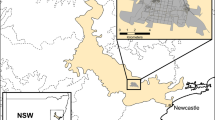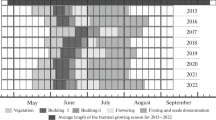Abstract
The family Carlemanniaceae in East Asia and tropical Asia, comprising two genera, Carlemannia and Silvianthus, are mainly distributed along the southern foot of the Himalaya Mountains and the western and southern interface of the Yunnan Plateau. The main reproductive process for Carlemannia tetragona was verified as self-pollination by the pollination experiments in this work. Germination rates for seeds of both C. tetragona and Silvianthus bracteatus could reach 100% when the seeds were collected after two months, while the rates decreased to 25% when collection took place in the previous year. It was found that the seed had no dormancy stages, and their seed banks were of the Transient Soil type. In field observations, the dehiscence status for fruits showed that their seeds could not be ejected effectively by capsules for dispersal. After analyzing the temperature and rainfall data from the years 1971 to 2000, it was shown that annual rainfall, the lowest mean monthly temperature in a year, and the extreme lowest temperature in a month had a great effect on the distribution range of Carlemanniaceae, while the mean annual temperature had a lesser effect. The narrow distribution range of Carlemanniaceae was affected by multiple factors, such as the short pollen dispersal distance and the Transient Soil Seed Bank. The population sizes of Carlemanniaceae were also easily affected by the level of rainfall, not by any single variable.
Similar content being viewed by others
References
Thiv M. Carlemanniaceae. In: Kubitzki K, ed. The Families and Genera of Vascular Plants — Flowering Plants (Dicotyledons) VII. Bering/Heidelberg: Springer-Verlag, 2004. 57–59
Yang X, Peng H, Lu S G. A review of phylogeny of Carlemanniaceae. Bull Bot Res, 2006, 26(4): 397–401
He D M, Wu S H, Peng H, et al. A study of ecosystem changes in longitudinal range-gorge region and transboundary eco-security in southwest China. Adv Earth Sci, 2005, 20(3): 338–344
Solereder H. Ein Beitrag zur anatomischen charakteristik und zur systematic der Rubiaceae. Bull Herb Boissier, 1893, 1: 167–183
Majumdar S, Chanda S. Pollen morphology and taxonomy of Carlemannia and Silvianthus of the family Rubiaceae sensu lato. Trans Bose Res Ins, Calcutta, 1978, 41(3–4): 99–105
Fedotova T A. Morphology of the fruit and seed of Carlemannia species (Carlemanniaceae). Botanicheskii Zhurnal (Moscow) (in Russian with English abstract), 1996, 81: 24–34
Tange C. Silvianthus (Carlemanniaceae) a genus and family new to Thailand. Thai Forest Bull (Bot), 1998, 26: 59–65
Savolainen V, Fay, M F, Albach D C, et al. Phylogeny of the eudicots: A nearly complete familial analysis based on rbcL gene sequences. Kew Bull, 2000, 55: 257–309
UNEP. http://www.wcmc.org.uk/infoserv/countryp/vietnam/app5.html
Zhou C H, Wu S H, Dai E F, et al. Vapor corridor phenomenon & response of vegetation NPP in Longitudinal Range-Gorge Region. Chin Sci Bull, 2006, 51(supp): 97–107
Sun H, Zhou Z K. Seed plants of the Big Beng Gorge of Yalutsangpo in SE Tibet, E. Himalayas. Kunming: Yunnan Science and Technology Press, 2001
Kruckeberg A R. Biological aspects of endemism in higher plants. Ann Rev Ecol Syst, 1985, 16: 447–479
Hong D Y, Ge S, Zhang D M, et al. Principles and approaches to studying the mechanisms of plant rarity and endangerment. In Qian Y Q, Zhen R D, eds. Advances in Studies on Biodiversity. Beijing: China Science and Technology Publishers, 1995. 125–133
Wang C Y, He Z R, Zhu W M. Outline of vegetation in Dulongjiang River watershed, Yunnan. Chin J Ecol, 2001, 20(Supp.): 26–33
Feng J M, Wang X P, Fang J Y. Altitudinal pattern of species richness and test of the Rapoport’s rules in the Drung River Area, Southwest China. Acta Scientiarum Naturalium Universitatis Pekinensis, 2006, 42(4): 515–520
Baker H G. Seed weight in relation to environmental conditions in California. Ecology, 1972, 53: 997–1010
Eriksson O, Ehrlen J. Phenological variation in fruit characteristics in vertebrate-dispersed plants. Oecologia, 1991, 86: 463–470
Moles, A T, Westoby M. Latitude, seed predation and seed mass. J Biogeo, 2003, 30: 105–128
Westoby M, Jurado E, Leishman M. Comparative evolutionary ecology of seed sizes. Trends Eco1 Evo1, 1992, 7(11): 368–372
Zhang S T, Du G Z, Chen J K. The present situation and prospect of studies on evolutionary ecology of seed size variation. Acta Eco. Sinica, 2003, 23(2): 353–364
Moles A T, Falster D S, Leishman M R, et al. Small-seeded species produce more seeds per square meter of canopy per year, but not per individual per lifetime. J Ecology, 2004, 92: 384–396
Moles A T, Ackerly D D, Tweddle J C, et al. Global patterns in seed size. Glob Ecol Biogeo, 2007, 16: 109–116
Yu S L, Marcelo S, Jiang G M, et al. The effects of seeds size on the distribution and abundances of plants and seed banks in a Mediterranean coastal sand dune. Acta Ecol Sinica, 2005, 25(4): 749–755
Airy Shaw H K. On a new species of the genus Silvianthus Hook. f., and on the family Carlemanniaceae. Kew Bull, 1965, 19: 507–512
Peng H. The Seed Plants from Mt. Wuliang in the South-Central Yunnan, China. Kunming: Yunnan Science and Technology Press, 1998
Author information
Authors and Affiliations
Corresponding author
Additional information
Supported by the National Key Project for Basic Research on Ecosystem Changes in the Longitudinal Range-Gorge Region and Trans-boundary Eco-security of Southwest China (2003CB415103)
About this article
Cite this article
Yang, X., Lu, S., Zhang, Y. et al. Factors acting on the distribution region of Carlemanniaceae: Rainfall, temperature and the plants’ biological characteristics. Chin. Sci. Bull. 52 (Suppl 2), 244–250 (2007). https://doi.org/10.1007/s11434-007-7017-1
Received:
Accepted:
Issue Date:
DOI: https://doi.org/10.1007/s11434-007-7017-1




